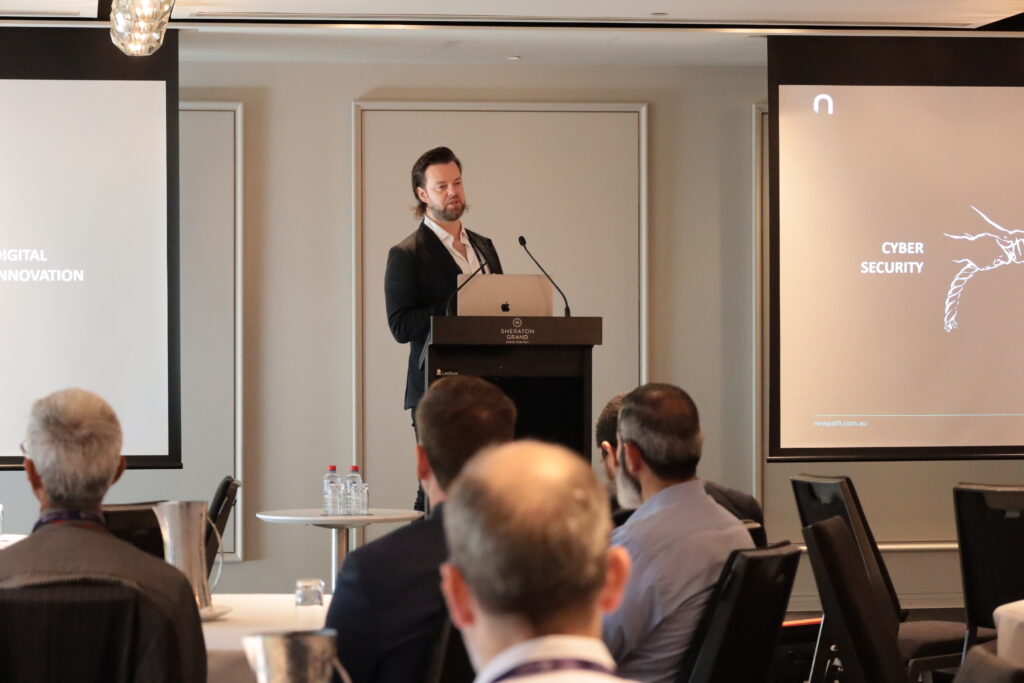
Hot off the back of a keynote address in Melbourne this May, we sat with Ben Dexter, our Chief Innovation Officer at Newpath, to discuss how AI has impacted life at Newpath and how we are leveraging AI for customer projects.
How do you envision harnessing AI to drive operational excellence within your organisation?
To be fair, we’ve been using AI across a range of internal and client projects for a number of years. However, since generative AI has come to the fore, we have seen opportunities to bake it into a number of BAU processes – and they probably fall into a a range of categories:
- PRODUCTIVITY: Document creation, personal/team organisation, and task management
- CREATIVITY: Creative outputs including design and copywriting
- IDEATION: Strategic and ideation outputs to rapidly generate tactical and strategy concepts
- DEVELOPMENT: Developer code assistants
As a personal insight, I have found that I am able to achieve fairly technical outcomes as a result of harnessing AI without developer input. This is where AI and No/Low Code platforms are really beginning to shine as they come together to democratise application development or the building of highly capable automated systems. Essentially, the combination of AI and No/Low code platforms allows me to rapidly and cost-effectively create PoCs, transforming ideas into operational technologies.
What are some specific areas within business operations where you see the greatest potential for AI implementation to enhance efficiency and productivity?
At a time where CIO’s are being told to do more with less, mainstream generative AI platforms could not have come at a better time. Products like Google’s Gemini and Microsoft’s Copilot are having a significant impact for BAU tasks in document creation, communication summarise, business intelligence, with more features being launched regularly. Microsoft boasts that Copilot could save each staff member up to 10 hours per month – especially for those that spend much of their time in the office suite.
We are currently undertaking projects to implement AI-driven Business Intelligence technology, aiming to effectively democratise data reporting through chat agents, as in, tools to “chat with your data”. Initially focusing on Microsoft Dynamics 365, we are building agent bots in Microsoft’s Copilot Studio ultimately allowing users to query their own marketing, sales and financial operations data using natural language. This is an exceptionally exciting frontier.
Large Action Models (LAMs), is where the rubber will really hit the road in terms of massive productivity gains (watch the Rabbit R1 keynote for fast and comprehensive explanation of LAMs).
In your opinion, what are the key challenges or barriers that need to be addressed when integrating AI and ML into any business processes?
If we look at recent examples that we’ve faced for integrating AI into Business Intelligence, a key challenge is ensuring that the underlying data is standardised and follows quality standards. It is common to receive unpredictable results (or “hallucinations”) due to data inconsistencies. Really, the game hasn’t changed here: in order to produce accurate reports, the underlying data sets must follow data standards. AI is not a silver bullet to solving poor data. However, once we have solved these issues the outcome has produced phenomenal efficiencies. Rather than requesting reports from IT and waiting for the BI specialist to produce a report days later, users can gather the data insights they need within seconds using agent UIs.
A big challenge is privacy and security. It is all too easy for individual users to share customer or company data with platforms like ChatGPT or Copilot. While Microsoft has produced a lot of documentation and privacy safeguards have been baked into their UI and the underlying technologies, it is still a minefield to manage privacy and security. So we recommend that before any individual users interact with generative AI tools for professional purposes, CIO’s should devise AI policies and educate staff in best practices. We have seen some business implement short online courses to implement these best practices. This can be a highly effective way of instilling both effective usage of generative AI tools (such as prompt engineering tips and tricks) and data privacy practices.
CIO’s considering new AI-based technologies need to deeply scrutinise vendors on their data security and privacy guidelines to ensure the underlying Large Language Models (LLM) are not being trained on customer data sets.
Can you provide examples of successful AI implementations in other organisations that have led to significant operational improvements?
We have a client with whom we work to integrate their AI/ML technology into web-based finance application processes. Where finance applications would take hours or sometimes days to complete, they are now instantaneous. However, the client identified that certain checks and balances needed to be added as a result to better manage credit defaults. So, while they were able to rationalise their headcount for applications processing, exceptions reporting was required to adjust the acceptance criteria and underlying algorithms.
We have clients that have implemented AI Chatbots, significantly streamlining the online customer experience. This technology has improved dramatically in the last two years and is set to only get better.
We are currently building a AI-BI prototype for a client who works with CFO’s in the healthcare sector to better manage resources, finances and government funding inputs. This promises to be an exciting project as we are aiming to build an AI-driven chat agent within a cloud-based application that connects to underlying financial data. It will allow CFOs and business managers to query complex data sets in natural language, instantly returning data results and visualisations. The next frontier for this project will be to then introduce predictive models helping to drive better financial outcomes.
Ultimately, there are immediate opportunities for businesses to explore AI across all aspects of the business from a digital perspective. But success should be tempered with an understanding of the IT governance issues AI introduces at both executive and board levels.
How do you prioritise AI and ML projects within your IT roadmap, considering both short-term gains and long-term strategic objectives?
In a recent partners workshop, Microsoft shared that 90% of their Copilot subscription sales were for small cohorts of users within large organisations. Anecdotally, CIOs are taking the approach of assessing the technology with small user groups to essentially build a case study for broader application across the organisation. First hand, we are also seeing this pattern across our own clients at Newpath.
Like many emerging technologies that have launched over the years, it is important to initially understand the negative and positive impacts that a new technology may yield for an organisation.
When I am building IT strategies and technology roadmaps for our clients, I will often build a prioritisation matrix where we identify technology initiatives based on expected value versus cost. We may then prioritise high value / low cost projects along the roadmap or transformational timeline. Once these quick wins have been identified, we will setup prototype environments, test the technology on small teams or clients groups, get a sense of the value generated from the exercise and then produce a business case. In the case of AI projects where external platforms, such as GPTs, may be readily engaged, IT governance measures must be explored during this process helping to advance business readiness.





